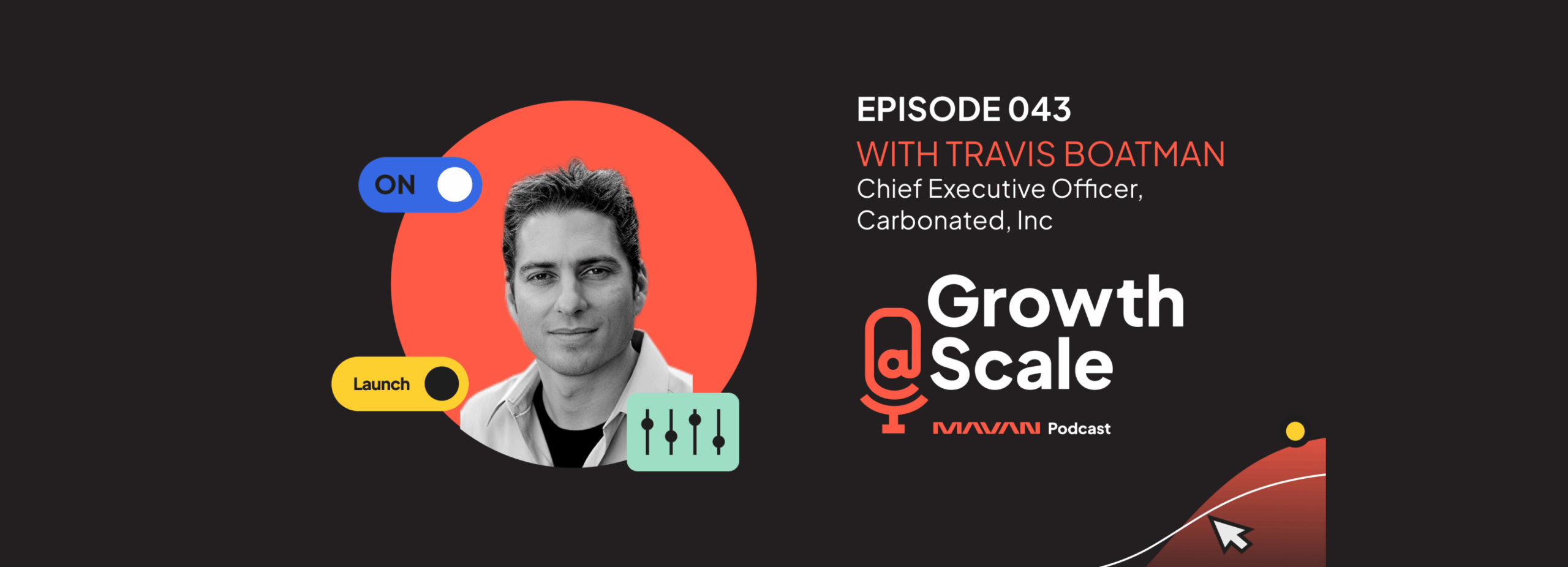Matt Widdoes
Welcome to Growth at Scale. I’m your host, Matt Widdoes. This is a podcast for leaders who want to bring sustainable, predictable, scalable growth to their businesses. Every episode I sit down with world -class growth experts across product, marketing, finance, operations, you name it. The hope is that these conversations will give you real, actionable advice for building and sustaining company growth. Our guest today is Aurelie Guerrieri, Chief Marketing Officer for Datadome and the author of the Mobile Natives Guide to Advertising. Today, Aurelie and I will talk about the similarities and differences in marketing B2C and B2B businesses.
Matt Widdoes
You know, maybe one place to dive in. As we think through in the broader landscape of late -stage growth, you also started your career in B2C and you moved into B2B. I’m curious if you could talk a little bit about that transition and some of the differences that kind of came to light as you moved from B2B to B2B.
Aurelie Guerrieri
It is fascinating how much there is in common, but also how different the spaces are. So obviously, it sounds very trite to say this, but you are marketing to people. And keeping that in mind helps you make the right kind of decisions when you think about creating that emotional connection, when you think about the kind of ads you’re creating, the media that you’re utilizing. So for example, you know, video is very strong in B2B and in B2C. I mean, nobody in their right mind wants to read a 10 -page white paper versus watching a two -minute video. That’s true if you’re doing research for work. That is true if you’re doing research for as a consumer. The difference, the big difference is that if you’re a B2C marketer, you’re shouting with a broader megaphone and you typically have a larger budget, a larger audience just in the first place. You’re selling to millions of consumers, if not hundreds of millions, of consumers versus in the B2B world, your target market is much more narrow. And so there’s one side of the coin, which is it is very, very helpful to have B2C experience going into B2B because you learn digital marketing at scale and with a velocity that enables you to have really, really good understanding of the mechanisms and what works and how you track and how do you assess performance and how do you understand touch points. And this is something that you can bring super effectively in B2B. But on the other hand, you’re going to end up in B2B just not having enough data to make statistically significant decisions. Like sometimes you can’t, especially early stage, A -B tests don’t even make any sense because you have 10 ,000 visitors to your website. And so, you know, the likelihood that you’re going to see a big difference or you’re going to see a difference fast is very, very low. So it’s marrying this, data -driven approach with more of an intuitive understanding of what is happening. And the beauty of it is you have less customers, which is also making it a lot easier to go talk to your customers, go understand their pain points, go understand how they research, how they think, interact with them in person as well. It’s a lot easier to get a feel for the market in B2B.
Matt Widdoes
I’m curious, by the way, on that point, how many companies maybe just as a percentage that you’ve worked with or you’ve been engaged with or you’ve kind of been aware of, how many do you think actually go out and talk to your customers?
Aurelie Guerrieri
I think the bigger question is how many marketing teams do. Because unfortunately, those communication points are often not making it to marketing. And as you’re right, Matt, it’s way too often that you have marketing teams that are getting their information second hand. And interestingly, the advent of remote work has made it easier and harder in a way. It’s kind of easier to jump in as a fly on a wall in a meeting, but it’s also harder to make that happen organically. Versus if you’re in an office, you see a customer comment, you say hello, you spend five minutes with them, you have a much more organic conversation with your customer, versus formerly scheduling and getting on a phone there. So in many companies I’ve worked at, I have had to institute a practice of regularly talking to customers, also talking to customers in a coherent, consistent way so you can start getting insights and not just little feels here and there. And it’s about collecting 360 feedback, so collecting direct feedback from customers, feedback through your customer review sites like G2s, etc., doing short surveys, but also deep dive one -to -one with customers and customer advisory boards. It’s about hearing from your customer service team, from your sales team, so getting a lot of data points. But yeah, it’s a muscle that needs to happen. I will say, I’m going to plug Gong here. I’m in love with how powerful the product is and I would encourage every marketer to listen to Gong calls, like go on walks and I listen to Gong calls, I drive a commute to work and I listen to Gong calls. I mean, you hear the real, you know, unvarnished problems that your customers have and they’re trying to solve and working with you.
Matt Widdoes
Yes. Okay, great. I think speaking of, you know, there are many bad habits that organizations develop over time. One of those, from my perspective, is not talking to their customers or not doing it frequently enough or not sharing those learnings or not having any real rigor around how that’s done. If you could rewind the clock and change things or if you find any kind of what we sometimes call scar tissue that’s left behind, you know, are there any kind of consistent things that you’ve seen over time and how, you know, can companies stay ahead of those?
Aurelie Guerrieri
My big one is metrics versus insights. And there’s not a single team I’ve worked with that I haven’t had to have that conversation with. I’ll give you a very specific example. I came to a company where the marketing team was showing MQL numbers, so marketing qualified leads numbers that were going up and to the right. So they were patting themselves on the back, being very happy. And then we had a sales team that was in shambles because they were missing their goals. So you come in there and you say, you cannot be successful as a marketing team if your sales team is not. There’s clearly some disconnect here. And fundamentally, I think ease of access of digital marketing, the ease of access of data means that it is super, super easy to pull a ton of reports. And every single tool is guilty of this. You have the standard CMO dashboards that have all kinds of data sets, pretty looking charts, but they don’t mean anything. They don’t get you to any insights to help you understand what is really going on. And in that company, that example that I just gave you, I had the sales and the marketing team sit around the table and start breaking down the entire flow between a marketing qualified lead and a sale and understanding every single step of the way, measuring conversion rate and measuring velocity. Did not get fixed overnight. It took us a year, but within that timeframe, every single aspect was methodically optimized step by step. And we were just very impartially looking at the data. There was nothing personal. Everybody’s sitting around the table fixing it. After a year, we were able to improve the conversion rate 300% and the velocity 80%. And so that’s what I’m talking about. When you get to the end site, you can actually take action and you can fix things and you can see if it works or not, versus just looking at the metrics and it doesn’t tell you any story, it doesn’t tell you anything, it’s just looking at it and you’re just kind of shaking your head thinking, oh, okay, that’s nice. For me, that’s the worst that can happen.
Matt Widdoes
That’s funny, it highlights another problem that I’ve seen a bunch in is kind of cliche at this point where you’ve got the sales team is pointing at the marketing team and saying, they’re not giving us good enough leads, that’s why we’re not closing sales. The marketing team is saying, well, if the product team would put in these features that we know our customers want and would make us more competitive, we would be able to sell more and we would be able to attract more people. And again, it takes a village to grow a company. How do you think about those core, connective pieces both inside and outside of marketing and the various roles and how they support each other?
Aurelie Guerrieri
You’re completely right. There’s an easy tendency to finger pointing. There’s an as easy tendency to say, oh, everybody, let’s work together. We’re one team. But pragmatically, if you’re a CEO, how do you know that people are working together? Is the question I get often? What are some specific things you can check for to say, yes, the teams are really jelling, they’re working together versus no, there’s these silos and they’re not talking to each other. So between marketing and sales, the things I typically look for is that, is there a mutual appreciation? Right. Our people. you know, proactively reaching out and say, oh, thank you, that event just worked really, really great. Or, oh, you did great work on this customer, you know, good job signing them, like little things like this, right? But also the transparency around data that we talked about earlier, being able to sit around the table and without any emotion, just looking at the entire lead to deal flow and saying, let’s just break it down and just attack step by step and get it better. And if you have that, then that’s kind of a bare minimum. And then you can build on that with programs like account -based marketing, you know, joint efforts, et cetera. But you can’t really do that if you don’t have the foundational relationship. With product, I think the other aspect is, is there technical fluency in your marketing team? Do they really understand the product? Are they product users? If they can be product users? Are they tinkering around? Are they playing with the demo? You know, is there an interest for the product? Often I find, you know, some marketing teams are very mercenary, which I appreciate, but there’s a need for understanding what it is that you’re trying to sell to get with a customer, right? And then the synchronicity. Product is often a few steps ahead, you know, in terms of roadmap, but the difference between what you’re ready to communicate to your customers as a marketer versus what product is ready to communicate is actually important to time properly. So as a marketer, you need to build thought leadership around the upcoming features to create interest in the market and then be ready to launch. So having that synchronicity is super, super important. Back to what you’re saying, I think one of the ways to get that ownership, that sense of ownership is also to really lean into the customer centricity. So we’re talking about internal relationships, but the most important relationship is with your customer. So it’s really understanding, are you digging into those pain points? Are you digging into how the customer is using your product, why they’re using it? And often I find that we have a tendency to be very bits and bytes driven, be very technically… oriented when we talk about why the customers are using this. In cybersecurity, for example, you realize that most CISOs have about 50 to 70 tools. Again, if you do not solve a bigger order of magnitude problem for them, even if your tool is awesome and it’s a great prevention tool, it would be really useful if they had the latitude of implementing a thousand tools. The reality that they’re going to give you a minute of attention is nil. Understanding what is the bigger problem that my customer is trying to solve and how do I enable this? Often, they’re not really using your product for its ends and purposes. They’re trying to accomplish some bigger goal for the company. They’re trying to drive digital transformation. They’re trying to drive growth and scale, and you are one enabler of this. Understanding that and how you fit into that bigger picture is really important as a marketer because it helps you gain that empathy, but also understand where the market is going. What other solution can potentially come in and solve the same problem you’re solving in a completely different way?
Matt Widdoes
So a good portion of our audience will be CEOs or leadership co -founders at companies that have recently raised or are about to raise maybe less than 10 million, let’s say, and they’ve maybe shown some product market fit. They’re just now starting to scale in a more significant way. What kind of parting advice would you give to leadership teams or boards of early signs of success that are now kind of growing up in some ways or kind of going from their first, you know, 20 people and going to their first 100? What kind of parting advice might you leave a CEO of a company of that size?
Aurelie Guerrieri
I think what’s really important is positioning at that scale. And so that is the nexus of product marketing, brand, and really what the CEO stands for. And the CEO is still a selling CEO at this stage. That positioning work is really important to get done with alignment with the rest of the executive team. So often I find that trying to go through a positioning exercise with four or five different execs, you know, some co -founders, some new execs in there, you realize that while there’s typically a general sense of alignment of what the company stands for, when you start putting words on paper, you realize that not everybody has 100% align and there’s slightly diverged, you know, diverging views on where the company is going or the company might be going. Instead, going through that exercise really, you know, word by word can be very, very helpful. Sometimes I, you know, I say it’s a birthing, it’s collective birthing exercise, right? You take everything that is in everyone’s mind and you try and align it. And I think at that stage it’s super, super important because once you have the alignment, then everybody’s empowered to scale. You can just let them go and you know that when you touch base again, six months from now, 12 months from now, like, like everybody will still be aligned with this. So as you scale, I think that’s one of the things I would focus on.
Matt Widdoes
Yeah, okay, great. Well, thank you so much again for the time today. Always a pleasure speaking with you and I look forward to the next time.
Aurelie Guerrieri
Thanks you for having me, Matt.
Matt Widdoes
We hope you enjoyed our chat with Aurelie Guerrieri on the differences between B2C and B2B marketing. Thanks for listening to Growth at Scale. Check back soon for more chats about growth. Find more episodes, conversations and blogs at mavan.com. See you next time.
Book a complimentary consultation with one of our experts
to learn how MAVAN can help your business grow.


